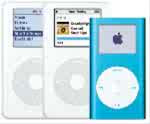
After much discussion with Apple over the past couple weeks, record label EMI said, starting this May, they will begin selling music without DRM piracy protection via the iTunes store. But is Apple actually in favor of DRM-free music on iTunes? I believe they are not. And strangely enough, DRM-free music could have adverse effects on Apple and the sales of the iPod.
I am a firm believer that Digital Rights Management (DRM) simply doesn’t work. Given that, I am also a strong supporter of what EMI is doing with online music downloads. These freedoms allow purchasers of online music to make multiple copies of their music (much like it would had they purchased a CD) which will most importantly allow the transfer of their songs from one device to another.
Perhaps the most logical thing I’ve heard from any record label was from EMI’s own Managing Director, Mohan Mahapatra, who said, “If you think you can steal music, you will steal it anyway. Even if it has DRM, you would crack it and steal it. So if you don’t want to steal it, you will buy it. So you might as well give the people who buy music legally a better proposition.”
Many music labels are restricting material that we have purchased, while the ones who pirate copyrighted material (those who actually justify the use of DRM) will do so in any case with DRM cracks.
To make matters worse, DRM is even forcing genuinely honest people to resort to illegal activities just to get their media on other portable devices.
Apple’s Steve Jobs talked previously about the disadvantages of DRM, stating he would surely switch to DRM free music in a heartbeat, if only the music labels would let him. The time has now come; the anti-DRM movement is starting to come to fruition, and it’s only a matter of time before other labels follow.
However, many seem to miss what DRM has done for Apple, the iPod, and iTunes. People are even willing to pay a premium cost to download music without restrictions, according to a recent poll on Pocket Lint. It may possibly be a good time for Apple to re-think their strategy.
Apple’s downloaded files come with restrictions on their use, enforced by FairPlay, Apple’s version of digital rights management. Of course, Apple’s format, AAC, combined with FairPlay-encoded files are not compatible with any music devices other than Apple’s media players.
By providing downloads without the anti-copying “digital-rights management” software, “we aim to address the lack of interoperability, which is frustrating for many music fans,” EMI CEO Eric Nicoli said.
‘Lack of interoperability’ meaning that iTunes purchased music will no longer be exclusive to the iPod, giving consumers the freedom to use ANY device they wish to play their media.
Jason Reindorp, head of marketing for iPod competitor, Zune, said this move ”does open things up a little bit. It potentially makes the competition more of a device-to-device or service-to-service basis, and will force the various services to really innovate.” As for Microsoft’s Zune, an EMI spokesman confirmed that negotiations with other platforms were still ongoing.
According to Boyd Peterson, an analyst at Yankee Group, the iTunes Music Store isn’t the moneymaker; it’s only used to sell iPods.
That method has worked quite well for Apple, with 48% of all Apple revenue being attributed to the iPod alone. But the times are changing, and giving users the freedom to choose any media player they want may prove to put a dent in the sales of the fastest selling music player in history. If anything, it will certainly open the door for 3rd party mobile media devices and other devices to gain popularity in the market.
So what will Apple ultimately do? Within the next couple years, they are likely to shift their attention from the iPod to iTunes; Apple’s innovative attention to detail, while creating a clean and simple user interface, has clearly made the iPod what it is today. But to keep “all things Apple”, they may be forced to overhaul the iTunes service.
Some have hinted towards iTunes adopting a subscription service, where members will pay a flat rate per month and have the ability to download anything and everything they wish.
A subscription-based model sounds good for the consumer, and possibly good for iTunes to keep their customers. But given the move toward DRM-free music, it would never stand a chance; subscribers would sign up for service, copy the entire list of music, and simply cancel their subscription the following day.
Adding more media has always proved a good approach for iTunes; the recently announced deal with MGM Studios to offer classic movies such as “Dances With Wolves” and “Rocky” has expanded the iTunes catalog to offer over 500 movies making it that much more ‘attractive’ over competitors.
But the real winner in this game will ultimately be the first service who adopts an across-the-board DRM-free music collection at a reasonable price.
 When Sony released it’s very first digital audio portable players (DAP) the only supported format was ATRAC and then ATRAC3, after miserable sales, Sony finally decided to support MP3 but that was many years too late. ATRAC3 is a superior audio format, allowing for lower bit-rates but still maintaining the same audio quality of higher bit-rate MP3 files.
When Sony released it’s very first digital audio portable players (DAP) the only supported format was ATRAC and then ATRAC3, after miserable sales, Sony finally decided to support MP3 but that was many years too late. ATRAC3 is a superior audio format, allowing for lower bit-rates but still maintaining the same audio quality of higher bit-rate MP3 files. 









































